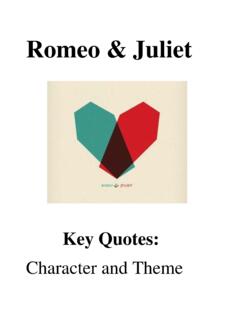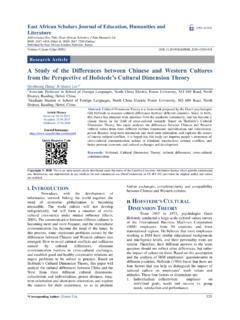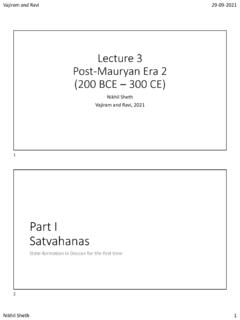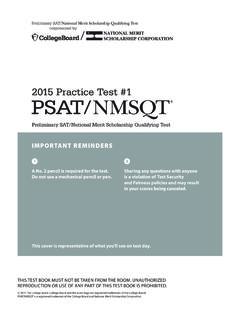Transcription of WHEN WE TWO PARTED - GCSE English Revision
1 when WE TWO PARTED By Lord Byron (1788 1824) when We Two PARTED is thought to be based upon one of the many scandalous relationships Byron was involved in during his lifetime. He was notorious and labelled mad, bad and dangerous to know. It Context is claimed that Byron falsely stated the poem was written in 1808 in Wellington. Byron was a leading Romantic poet. order to protect the reputation of the lady it was written about, Lady Frances Webster, and was actually written in 1816. Lady Webster was also said to be involved in an affair with the Duke of THEMES: Secret, forbidden Love Regret Pain, Loss, Death Anger COMPARE WITH: Neutral Tones Winter Swans Farmer s Bride Porphyria s Lover The title refers to the painful moment the relationship ended and speaks directly to the woman, to confess the poet s reactions and response to that day.
2 Stanza 1: The silence suggests many feelings unspoken, either because this is not a mutual parting, or because there is a forbidden, secret aspect to the relationship. This is further indicated by the poet being half-broken hearted and that he will be scarred by the experience for years - sever . Stanza 1: The woman is described as becoming cold and emotionless, all warmth they may have shared is now dying. Stanza 2: Pathetic fallacy used to further the cold atmosphere dew of the morning . Stanza 2: The woman s reputation is now light , possibly as the result of another or even this scandal, and the poet, due to his secret involvement with the woman shares in the shame . The unnamed people of the society of the time are gossiping and criticising the woman.
3 Stanza 3: The pressure of public opinion and reputation continues into stanza 3. The rhetorical question suggests that the poet is emotionally traumatized by the affair even though he has escaped with his anonymity intact. Stanza 4: The tone begins to turn to anger and bitterness as the poet acknowledges he is left with deep emotional wounds long shall I rue thee Stanza 5: The poet confesses the secret nature of the relationship and the tone change continues as the poet feels he has been deceived and forgotten by the lady. Stanza 5: The poem returns to the beginning, in silence and in tears. The poet has been unable to move forward since the parting and does not see himself being able to move on in the future.
4 Organised Notes Additional Notes The poem is about the painful end of a relationship, with suggestions that it was a secret and forbidden love. It is told from the viewpoint of the poet who is struck by grief. It has bitter and melancholic tone. The structure of the poem is regular in rhythm and rhyme and highly controlled. It signifies a sense of deep reflection about the day and the relationship, as though the poet has considered it very carefully. Although the poem moves between time frames (past, present and future) the repetition of silence and tears at both the beginning and end creates a circular structure. This shows that poet is unable to move forward and is stuck with his despair. The poem uses a semantic field of death.
5 The poem is riddled with references to death and loss. Pale, sever, knell, grieve etc. The death of the relationship is also a death of his happiness, emotion and future. He is mourning the loss of his love. The poem uses language to foreshadow the inevitable end of the relationship. Part of the poet s bitterness comes from the signs that surrounded him that the relationship was doomed. Foretold, warning, knell, deceive etc. There is anger that he gave so much love and yet he was ultimately rejected. The poem juxtaposes knowledge and silence/secrecy. There is a clear contrast between the knowledge the poet has and the knowledge of others. They know not I knew thee In the same way there is a sharp contrast between the silence of the couple and the gossiping voices of others They name thee before me.
6 Grief Lament Confessional Melancholic Notorious Anonymity Mourning Forbidden Regret Bitter Scandal/ Inevitable Scandalous Foreshadow Pathetic Fallacy Doomed Rejected Juxtaposition Wounds AO1: Read, understand and respond to texts. Students should be able to: maintain a critical style (Ambitious Vocabulary, Organisation) and develop an informed personal response (Point Opinion statements), refer to the text, including quotations, (embed them) to support and illustrate interpretations AO2: Analyse the language, form and structure used by a writer to create meanings and effects (Zoom in, Analysis), using relevant subject terminology (Techniques) where appropriate. AO3: Show understanding of the relationships between texts and the contexts in which they were written NEUTRAL TONES by Thomas Hardy (1840-1928) Thomas Hardy was a Victorian novelist and poet.
7 Much of his poetry is autobiographical, about his relationships and the failure Context of his relationships. He famously wrote a great deal of his poetry was influenced by the Romantic poets. about his first wife, Emma, who he became estranged from, and mourned her death for the rest of his life. Neutral Tones, however, was written about a previous relationship that did not last. Hardy THEMES: Pain, Loss, Death Bitterness, Anger Nature COMPARE WITH: Winter Swans when We Two PARTED Farmer s Bride The title neutral suggests something without warmth, cold and emotionless. It is the opposite of colourful. Stanza 1: The poem begins by setting the scene with a pathetic fallacy.
8 The combination of the pond, winter and white sun create a cold and bleak landscape. In addition, there is a sense of everything dying - the falling leaves, the starving sod natural elements, once fertile and alive and struggling to survive symbolic of the couple s relationship. Stanza 2: She doesn't look at him directly and hold his gaze, but instead her eyes rove moving constantly, wandering without fixing on him. He imagines that, as she focuses on everything but him, she is thinking over tedious riddles of years ago . This oxymoron creates rich imagery about the frustrations that are part of their relationship. Tedious suggest dull, repetitive and riddles is something that is a challenging puzzle both fun and infuriating.
9 These riddles, unresolved arguments have continued to plague them for years. There is no solution. Stanza 3: This stanza starts with another strong contrast, this time the juxtaposition of her smile being the deadest thing . This image is further extended with her grin of bitterness . What seems to be most painful for Hardy is that she once did smile with warmth and love at him, as it was once alive enough to have the strength to die . This smile, that turned to a grin of bitterness, should have been his ominous warning that the relationship was doomed. Stanza 4: This stanza shows a change in his emotion. In recalling some of the details of the day, the language has become increasingly powerful and bitter.
10 Hardy acknowledges that he felt deceived by love, in particular, this relationship. The sun has changed from white to God-curst indicating that his feelings are no longer neutral but angry and inflamed. Stanza 4: Wrings with wrong alliteration emphasises his anguish. Stanza 4: The irregular rhythm of the final stanza created by the mix of enjambment and caesura shows that Hardy begins to be overwhelmed with feelings of anger. However, as soon as this appears, it quickly dissipates. The anger fades using repetition of and Hardy lists the bleak elements of the scene that day that he associates with the futile and empty relationship. Hardy returns to his melancholic, sombre state, gazing at the pond, returning to the beginning.








